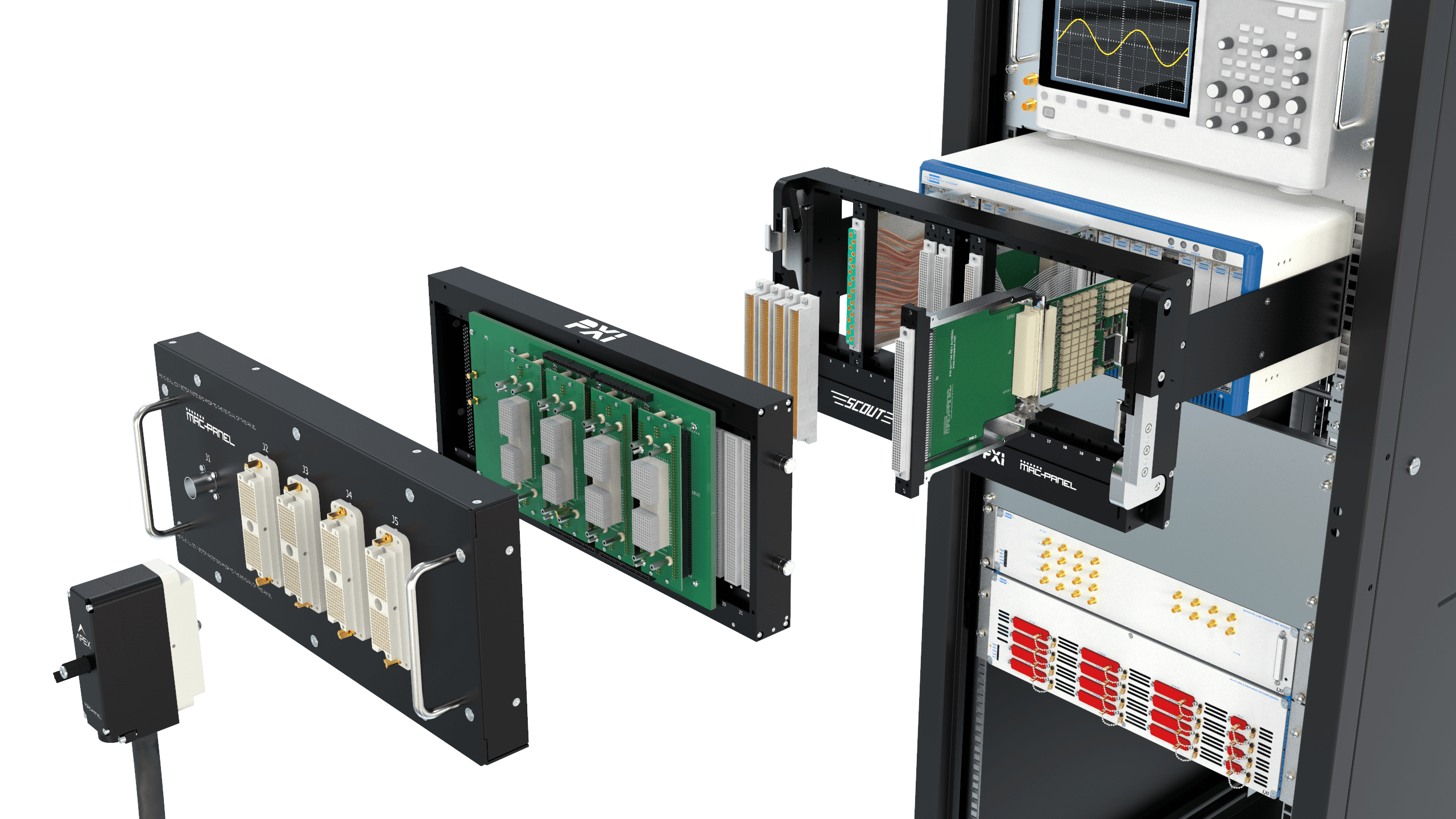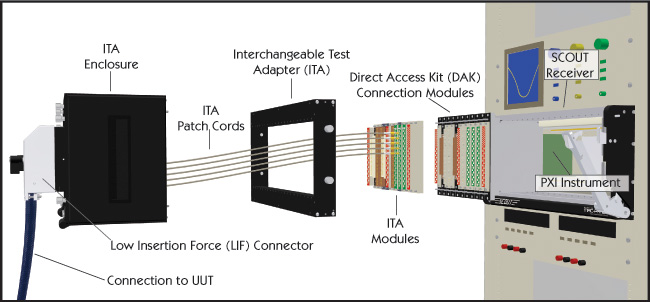
Advanced Mass Interconnect Technology
Reach the Full Performance Potential of the PXI Platform

I Am New to Mass Interconnect
SCOUT Solutions for NI PXI Technology
SCOUT is the only NI PXI Connectivity Solution specifically designed to deliver the full performance potential of NI PXI based test systems.
SCOUT Benefits
- Enhanced Electrical Performance
- Eliminates Conventional Wiring Harnesses
- Reduced System Integration Time and Costs
- DAKs specifically engineered to compliment NI PXI Instruments
SCOUT Benefits
Signal Performance
DAK (Direct Access Kit) technology is a pull through advanced mass interconnect interface solution that uses short length matched wires, flex circuit, and PCBs. The majority of DAKs utilize PCB designs which incorporate comprehensive signal shielding for optimum performance and include in-situ connection point that can be used to connect external resources.
SCOUT DAK,mass interconnect technology supports over 650 instruments from all major instrument manufacturers and the library of DAKs is ever expanding. SCOUT offers a variety of connection options to suit the different instrument I/O requirements and measurement technologies.
PCB DAK

The majority of DAK designs utilize a PCB for connection. All PCB DAK designs incorporate comprehensive signal shielding for optimum performance and include in-situ connection points that can be used to connect external resources. All connections between the PXI instrument are less than 6”, offering superior performance and signal continuity.
Flex Circuit DAK

Flex-circuit DAK’s offer all the same performance advantages of a PCB DAK but offer a particular advantage in very high density I/O applications. For example, 200 position connectors are a very popular choice for high density PXI switches and DIO. Using cables to connect these instruments is impractical and leads to severe performance limitations.
Short Wire DAK

Some instruments and signals inevitably require cable connections; which are typically RF or power connections. These connections are made in a short wire DAK. As with the other DAK designs, the connection length is 6”, offering superior performance.
System to System Stability
One of the benefits of the PXI platform is the ability to build identical systems when multiple systems are needed. The problem often comes in when the interconnect method is being designed. When attempting to use cables in a PXI ATE build we often times don’t realize that each cable for a specific project will be built differently however good the technician is that is building the cable. This variation in the mechanical build of the cables means that each test system will display different performance characteristics that will need to be calibrated out on a regular basis starting with the initial setup of the system thus increasing the time to test, production, and ultimately time to revenue. Eliminating cables, as much as possible, and using DAK technology means each system will be built with predominantly COTS items to ensure minimal differences between systems, independent of where they’ve been manufactured or are being operated – increasing the PXI value of system to system stability.

Reduced Time-to-test
In the ever demanding world of electronic test and measurement time-to-test, and ultimately time-to-revenue is of utmost importance. This is why it is important to choose a interconnect approach that is ready to be deployed once received.
Our research shows a significant increase in Time to Test in a cabled solution when compared to a SCOUT solution with the Time to Delivery spread between the two significantly increasing the higher and more complex the I/O – as shown in the chart below.

Time-to-test In weeks
Unprecedented Modularity
Simply remove a DAK Assembly and replace it with another or swap a DAK Assembly from one system to another system. In both cases, the process is typically completed in a matter of minutes and with no adverse impact on the system as a whole – the system is unaffected and unchanged. This is the opposite of a typical cabled interface where cables need to be moved or disconnected to remove an instrument and then need to be reconnected. This will often cause noise and cross-talk related issues and general system instability.

Ease of Maintenance
A cabled interconnect solution can be extremely hard to maintain. The higher the number of cables in a system the more difficult a system is to maintain and moving one cable to access an instrument often disrupts other cables. The use of self-contained Direct Access Kits (DAK) can eliminate this problem (see photo below). Utilizing this form of interconnect means that upgrading or maintaining a particular instrument will not affect anything else within the system thus enhancing the ease of maintenance that the PXI platform offers.

ITA Considerations
ITA stands for “Interchangeable Test Adapter”. The use of test adapters is a common practice amongst test engineers seeking to easily connect and disconnect each device under test (DUT) that is being test without disturbing the connection points between the receiver modules and the PXI instrumentation while also utilizing a single test station to test multiple electronic devices. The photo below shows an interchangeable test adapter (ITA) which brings the signals of the PXI instrumentation out to the DUT from the receiver modules of the test side of the system – making all those connections simultaneously.
Eliminating cables for ATE systems has been a key objective for system developers for many years, but the system design is only one side of the challenge. Test fixtures (ITAs) are also a critical element of the test architecture and are also susceptible to the negative influence of cabling – and the more complex the fixture and test design the greater the potential performance and stability issues. Two approaches can be utilized when designing ITAs for use in PXI test architectures, wired ITAs and PCB based ITAs. Cost and system to system performance and stability should be considered when deciding on which method is best for your application.
Cost
Wired ITAs utilize ITA patch cords to connect the ITA modules through to the DUT. These patch cords are housed within a ITA enclosure. Designing a wired ITA approach has its’ benefits. One of the main benefits is the low cost when producing only one ITA is needed when compared to the PCB approach under the same circumstances. The problem lies when producing identical ITAs. Wiring labor stays constant therefore when wiring identical ITAs, the cost remains static no matter how many ITAs are built. The opposite is true with PCB based ITAs. Producing multiples of the same PCB ITA can result in a reduction of cost when higher quantities of identical PCBs are being built.
System to System Performance and Stability
Again, when building only one ITA is needed, system to system performance and signal stability should not be an issue when looking at the use of a wired ITA. However, when producing multiple identical ITAs is needed it is important to note that performance and signal stability might be an issue. This is why the use of PCB based ITAs is suggested as the best choice when clone ITAs are needed. Wired ITAs have small variances within the mechanical build of each one being produced, thus leading to small variances in signal integrity that have to be calibrated out throughout the life of each test station. Also, these variances mean that although the test side of each tester is identical the testers as a whole can never be identical from one test site to the next. On the other hand, PCB ITAs are produced to very fine specifications and are always identical no matter when they are produced. This means that each test station will be a perfect clone of its’ sister stations thus producing identical results across all cloned test stations.

Getting Started
We recommend getting started building your SCOUT interconnect solution by exploring our DAK options, mounting hardware, or try finding a part using our parts selector. Click an option below to get started. Remember, our applications specialists are always here to help you. You can connect with us by visiting our contact us page.
PCB DAK
The majority of DAK designs utilize a PCB for connection. All PCB DAK designs incorporate comprehensive signal shielding for optimum performance and include in-situ connection points that can be used to connect external resources. All connections between the PXI instrument are less than 6”, offering superior performance and signal continuity.
Flex-Circuit DAK
Flex-circuit DAK’s offer all the same performance advantages of a PCB DAK but offer a particular advantage in very high density I/O applications. For example, 200 position connectors are a very popular choice for high density PXI switches and DIO. Using cables to connect these instruments is impractical and leads to severe performance limitations.
Short Wire DAK
Some instruments and signals inevitably require cable connections; which are typically RF or power connections. These connections are made in a short wire DAK. As with the other DAK designs, the connection length is 6”, offering superior performance.







